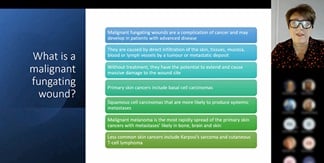Case description
Female patient 86 years, height 162 cm, weight 68 kg, BMI 25.91 with chronic venous insufficiency reported to the clinic in 2010 due to ulcer on the shin. Since then, the ulcers have occurred several times with periods of remission lasting few year. At present, in August 2016, a new ulcer of 6.2x 3.5 cm in size occurred on right leg in the area of ankle. It was concluded the patient suffers also from atrial fibrillation (treated with Xarelto and Polocard), diabetes, hypercholesterolemia. The USG-D study revealed full-length venous insufficiency. Arterial system was not blocked. ABI 0.85. Initially the patient was treated with Bactigras and HydroClean plus. Once the ulcer was cleaned with 70%granular ulceration and 30%of fibrosis, the patient was qualified for HydroTac. On the 28th day of treatment there was bleeding from the ulcer during the change of dressing in the clinic. Bleeding so strong that it was necessary to put on stitches and apply the Kaltostat dressing. The anticoagultion drugs Xarelto, Polocard and Agapurin have been discontinued. Low molecular weight heparin was included. A compression knee socks were applied, 3 degree compression with an additional compression sponge. The wound was checked after two days and the HydroTac dressings were applied again. After 14 days stitches were removed, treatment with HydroTac was continued. At present (ie after 114 days of treatment) the ulcer is almost healed, its current size is 0.5 cm2.
Conclusion
HydroTac has proven to be a good dressing for the treatment of moderate granulomatous ulcers in combination with pharmacological treatment and proper compression therapy.
It is also important to systematically clean the wounds in the clinic and dressing instructions given by the nurse to the patient.
Wound cleaning in case of taking anticoagulation medication must be very delicate and should be done only in a surgical room because an adverse reaction requiring immediate stitching might occur.
Clinical relevance
The more often the patient comes to the clinic, the faster the healing of the ulcer. The key role in healing ulceration is professional, systematic cleaning of the wound.
